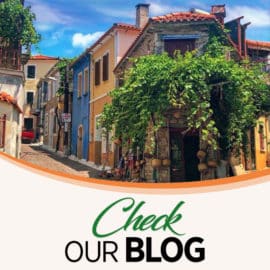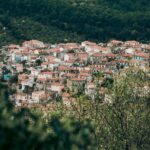This exhibition presents the traditional profession of the haberdasher and the haberdasher's shop in Agiasos.
😴
To learn more you'll have to wait just a bit little longer...
The loom in Agiasos was also called “bed”. The women of Agiasos wove on the loom all kinds of fabrics for their everyday clothes and their bedding with a variety of colors (red, ocher, blue) which they dyed themselves.
Actually, the dyes where made by dipping the threads in vegetable dyes, created from a variety of local plants and fruits.
From a mainly home art into a small industry
The result was to transform from a mainly home art into a small industry for the production of woolen clothing, textiles and carpets (“flokates”). Although the main professional occupation was the weaving of the woolen fabric for white and black capes: long for shepherds and farmers in Albania and Greece, short for sailors and fishermen in the Adriatic Sea.
Production of the weaver’s raw materials
The making of the threads, the carding, the spinning, the spinning, but also the work on the loom, required a lot of time and hard work and most of the women, especially in the rural areas, did these works in the spring and summer, when they finished the picking of the olives.
Materials and how they were used in the loom
Wool has always been the main material. It was laborious to prepare the wool until it was used on the loom: boiling in cauldrons with clean water, cooling and beating with a mallet, rinsing in water, drying in the sun, opening, carding (scratching on the cardboards). This is followed by spinning, for which they use the rocket or the shaft, where the finished thread is wrapped and the flywheel that gives weight to the shaft and strengthens the rotational movement.
After the hair is spun and spun, it is dyed. The colors become indelible, which is due to the essence of animal or vegetable dyes. After painting, the threads are spun with the help of a spinner. Specifically, the reed or bobbin is made, which is the wrapping of the warp in the straws of the weft in the bobbins, the diffuse, that is, the arrangement of the thread that will be the warp of the fabric. The winding of the saddle on the back instead of the loom. The mitoma is the passage of the warp into the beads and is of great importance for the type of cloth that the weavers will weave, as well as for its design.
Furthermore, as a raw material they used local cotton, flax, and sheep wool and most importantly silk, which they cultivated themselves until the end of the 19th century where there was a big silkworm disease in Lesvos which led to the decline of the silk production.
The different kinds of the woven fabrics
In general, woven fabrics are distinguished depending on the material (eg wool, wool silk, wool, linen silk), the construction technique (single cloth, double, double), the design or color (fiber, geranium), their use (medium).
Also, they are distinguished depending on their use in “houses”, wedding dresses and business (for needs that cover the occupations of the residents).
Today
To this day, traditional weaving is preserved by old experienced weavers in many rural settlements of Lesvos, such as Agiasos, Asomatos, Pigi, Lafiona, Agra and elsewhere.






